Operational and Strategic Progress in Ukraine: Identifying the Condition Changes - Global ECCO
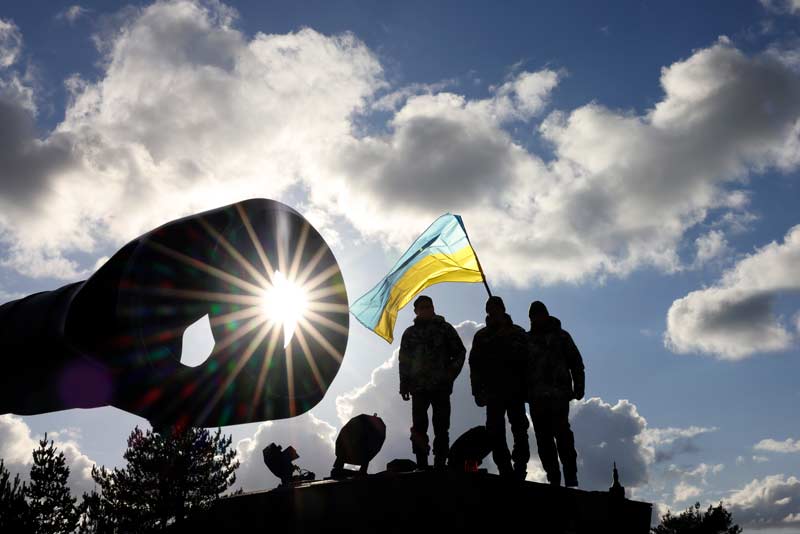
Operational and Strategic Progress in Ukraine: Identifying the Condition Changes
Guy Duczynski, Edith Cowan University; Sascha Dov Bachmann, University of Canberra and Faculty of Military Science, Stellenbosch University; Matthew Smith, DSM, defense contractor; and Charles Knight, retired Australian Army officer
Editor’s Note: In September 2022, ECCO Insights published an analysis by the authors of the early status (Day 54) of the Ukraine war and some potential trajectories. [1] Using a “factors and conditions” array called a Zwicky Box, the authors first illustrated the existing operational and strategic environments, and then demonstrated how identifiable shifts in the condition of specific factors could turn the conflict in Ukraine’s favor. We recently asked the authors to update their earlier analysis and provide us with both a snapshot of the current status (Day 460) and their assessment of how Ukraine and its allies have already and might once again move factors in Ukraine’s favor.
-----
The war in Ukraine continues. At the time of this writing, it has passed 460 days and there are no signs of it ending, nor indications of what conditions might prevail if it were to end soon. Russian President Vladimir Putin appears determined to secure at least the eastern part of Ukraine’s territory, cripple Ukraine’s economy, and neutralize it as a base for NATO. [2] Some analysts have described Putin’s “special military operation” as the leading edge of an attempt to reconstitute the Soviet Union, or at least to establish a new sphere of influence in Russia’s near abroad. [3] The Ukrainians appear equally determined and resolute that this will not occur. Meanwhile, nations providing support to Ukraine dither on the edges with offerings, albeit generous, of military hardware, training, finance, and other aid seemingly designed to at least preclude a clear Russian victory while not jeopardizing their own security by violating Putin’s self-declared “red lines.” [4] The accumulated effects of these offerings have not penetrated the Russian psyche to the extent that a military withdrawal is contemplated. A diplomatic solution seems equally unlikely for the foreseeable future.
_____________________________________________________________________________________
At the time of this writing, the situation might appear to be at a stalemate, with neither side having made noteworthy gains from February 2022 to June 2023. However, there are signs that the conditions have changed in a positive direction for Ukraine and, by extension, the West. The attritional battle for Bakhmut, the continuous probing into Russian territory by Ukraine-affiliated Russian volunteer units, and the significant preparations for a 2023 counteroffensive give hope for major Ukrainian territorial gains reminiscent of last autumn’s battlefield successes around Kharkiv and Kherson.
In our earlier article, we proposed a view of the operational and strategic conditions on Day 54, which occurred in mid-April 2022. [5] These conditions were then arrayed in Zwicky Boxes under factors that we considered central to a detailed expression of the conflict. [6] We identified these factors by asking, What determined the level of operational failure experienced by Russian forces in the first 40 days of the invasion? Given the imbalance in forces and direction of the aggression, this is a more meaningful question than, What determined the level of operational success experienced by the Ukrainians? Operational successes for Ukraine can only be evaluated by the extent to which they have frustrated Russia in achieving its objectives.
This article, therefore, seeks to identify the changes to operational and strategic conditions that have determined the scale and scope of any improvements or deterioration over the past 15 months or so. The detailed investigation of factors associated with specific military (and other) questions is a useful framework, and we note that other authors have made similar observations based on such an array of key factors. [7]
Operational Conditions
The value of a Zwicky Box depiction is that, given a reasonably complete expression of factors, it provides planners with clear lines of operation and indicators of where their efforts can be most effective. [8] Table 1 displays the seven factors that we identified, which will be discussed in more detail below; their associated conditions at the operational level on Day 54 are highlighted in amber. These conditions can be summarized by the acronym C3O2M3P2E4L3S1. [9] Note that some conditions describe the status of Russian forces, and others the status of Ukraine’s forces; these are indicated in the column headings. The condition descriptors toward the top of the table favor Ukraine and indicate a corresponding weakening of Russia’s position, while those at the bottom favor Russia. Aside from the strength of Ukrainian President Volodymyr Zelensky’s leadership, conditions on Day 54 generally favored Russia.
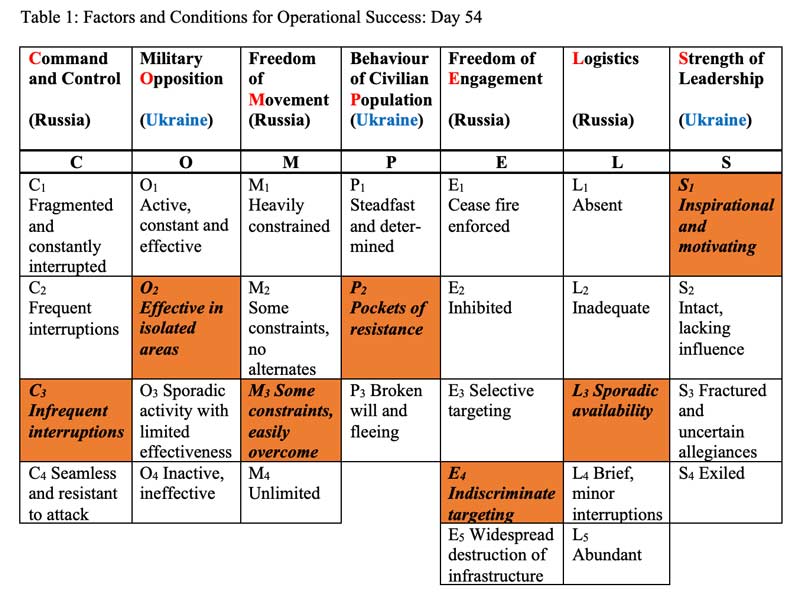
Our assessment at the time was that a configuration comprising C2O1M1P1E1L2S1 would place Ukraine in a highly favorable position. Thus, by focusing on specific lines of effort—for example, Russia’s freedom of movement and freedom of engagement—the overall picture could be shifted substantially in Ukraine’s favor. Keep in mind that a change in one factor is going to have some effect on others. This is consistent with military planning and is described as setting the pre-conditions for other endeavors to be achieved with reduced effort. For example, causing Russian forces to experience a loss of logistics (a condition of L1) for an extended period would deliver a major tactical advantage and invite Ukraine to initiate a corresponding period of expanded offensive action.
In contrasting the current operational conditions on Day 460 (30 May 2023; see table 2, where the conditions are highlighted in green) with Day 54, we see no reason to remove, add, or substitute any of the factors from the earlier assessment. We can readily locate a current view of the operational conditions on this table and thereby discuss any improvements or deterioration. Within this table, it is possible to position a new tipping point in favor of Ukraine that could lead to large-scale operational success and a Russian withdrawal, which we suggest is at C2O1M1P1E2L2S1[10] A change of conditions for Russia’s forces to heavily constrained freedom of movement and inhibited freedom of engagement would alter Russia’ warfighting capacity considerably. Indeed, on Day 460, the privately operated Wagner Group was the proxy force sustaining operations with regard to these two factors; however, it was experiencing its own difficulties and limitations even then, and is, as of this writing, in a state of uncertainty due to the brief mutiny staged by its leader, Yevgeny Prigozhin.[11] The only factor that currently still lies outside the parameters of the proposed tipping point is Russia’s freedom of engagement. The above-mentioned battle for Bakhmut and Ukraine’s partially executed counteroffensive may help shift this condition upward.
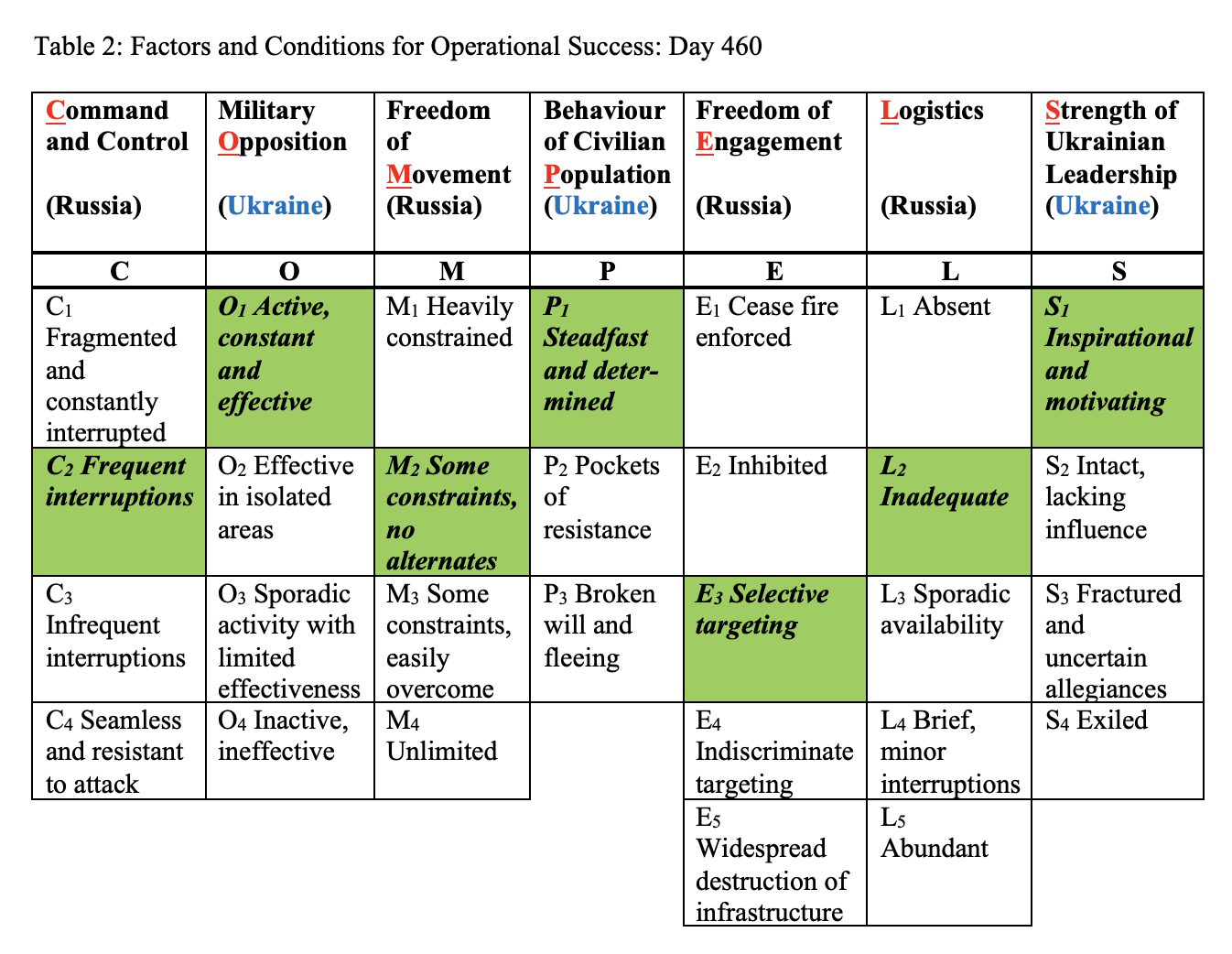
How did Ukraine and Russia, along with the other principal actors, get to where they are from where they were? Using the combined Zwicky Boxes in table 3 (where Day 54 is in amber and Day 460 is in green), a complete analysis of the plausible trajectories, or pathways, from April 2022 to May 2023 could be portrayed as in figure 1.
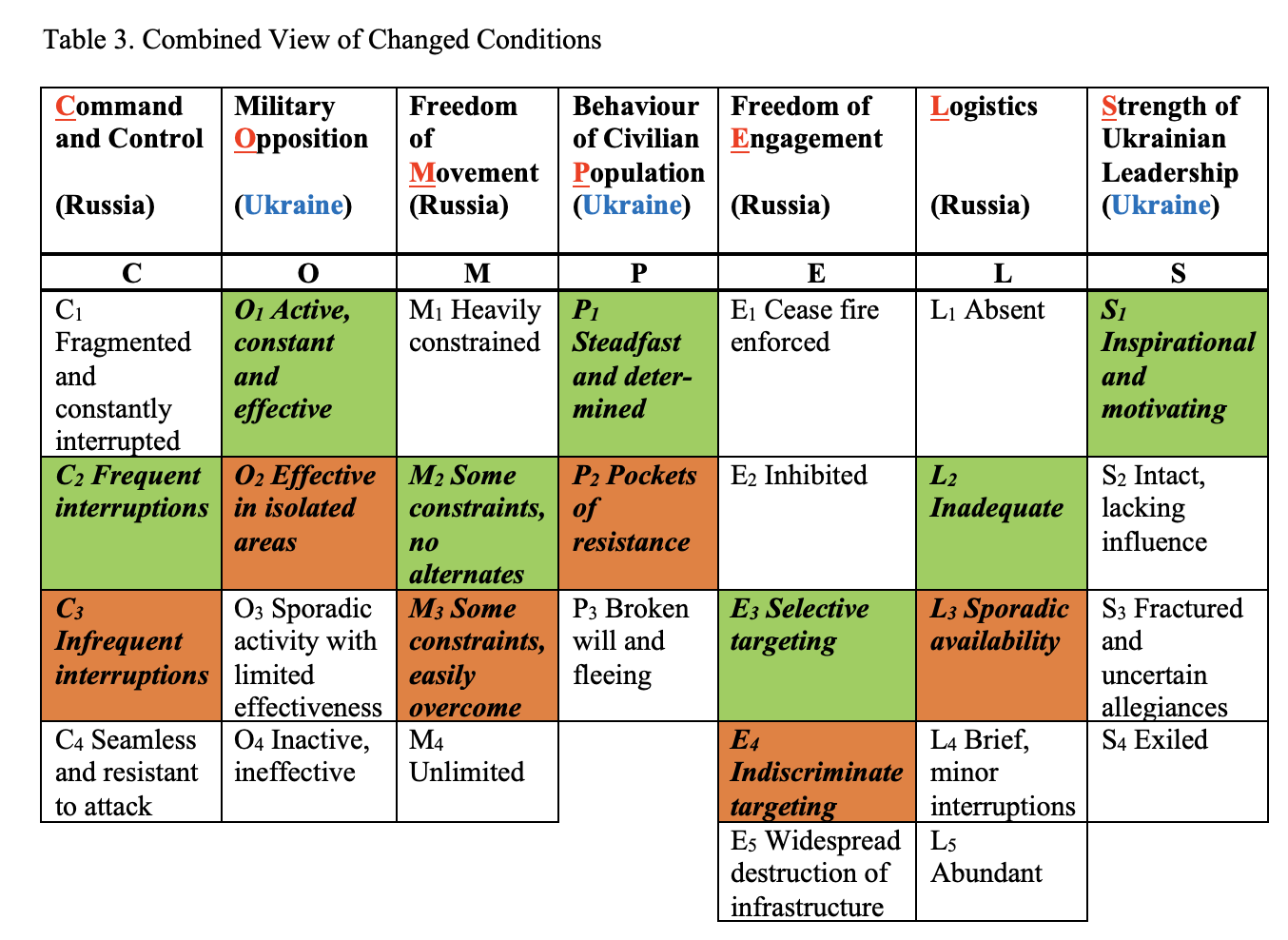
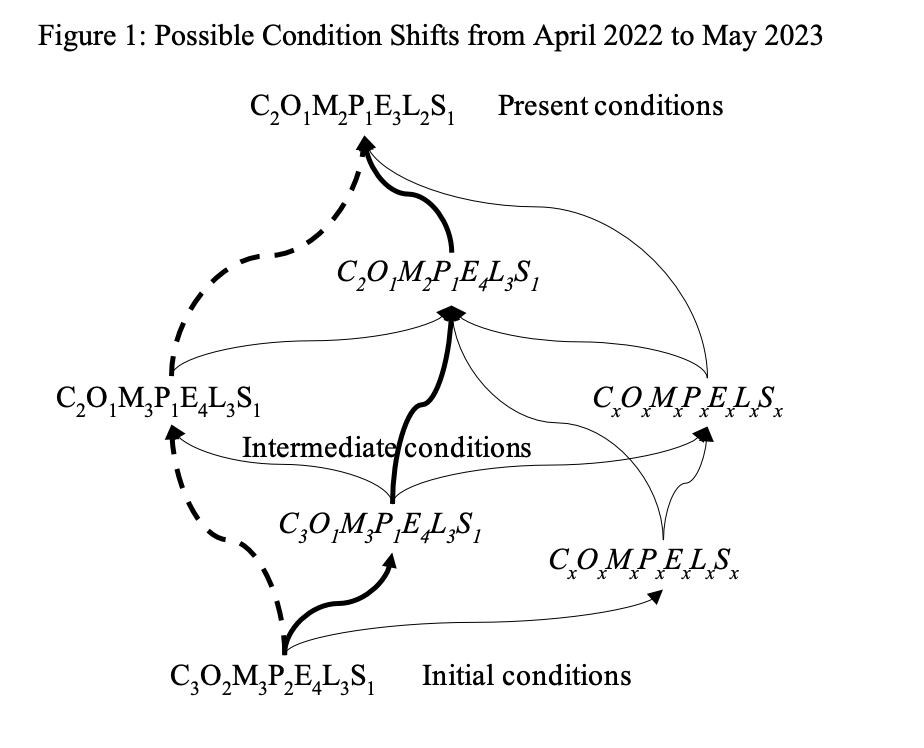
Although the tables may suggest otherwise, the conditions do not all abruptly reset as one from the initial to the present. Each of the factors is sensitive to events and, when linked, represent many plausible intermediate sets of conditions, each of which can be exploited by imaginative planners and sound intelligence. [12] To map these plausible and numerous pathways (we have depicted only a few), the question to be asked by planners is, Which one of the seven factors is most sensitive to one or more actions being taken? An immediate Ukrainian military opposition, ideally combined with a strong civilian population, would suggest where early attention might have been focused. Having arrived at this new set of conditions via the thicker line (C3O1M3P1E4L3S1), the next question is, Which other factors are now sensitive to effects?” and, What has the achievement of O1 and P1 set the pre-conditions for? We suggest in this scenario that Russian command and control could experience difficulties as a result of appropriate actions.
This is a highly valuable activity whereby planners align their actions with known or knowable changes in the system. It drives courses of action towards being more purposeful.
What follows is a brief description of each factor and what led to the changes in each assessment.
Command and Control: Condition Reset in Ukraine’s Favor
The inability of the Russian military to achieve a swift victory must be a source of frustration within the Kremlin, evidenced by the frequent removal of key leaders.[13] Additionally, a number of Russian generals (along with a significant number of senior officers) have been killed in the conflict; Ukraine confirms and names four and claims at least another four. [14] Many of these deaths are attributed to the individuals exposing themselves to excessive risk as they attempted to overcome slow progress, behavior that is often linked to an absence of effective command and control. Russian Defense Ministry briefings reported that two colonels, “being at the forefront, personally led the battle” and “heroically died after receiving multiple shrapnel wounds.” [15]
Coherence within the Russian armed forces also appears strained, with reported tension between the mercenary Wagner Group and the regular armed forces' chain of command that erupted into Wagner’s June 24 mutiny. [16] At the tactical level, the Russian forces are increasingly reliant on officers with combat experience to balance the inexperience of non-commissioned officers and poorly prepared Russian conscripts recently mobilized into the fight. This shortcoming is amplified by Russia’s inability to grow this needed operational capability, and has arguably been one of the key causes for the lack of command and control that has reverberated from the tactical ledge to the highest levels of command throughout the Russian campaign to date. [17]
Military Opposition: Condition Reset in Ukraine’s Favor
The Ukrainian military as a whole has been well-led and has shown great endurance under sustained attack by massive levels of firepower. There have been notable acts of heroism, and some units have demonstrated outstanding performance. [18] The capability is growing as the army shows itself to be a learning organization able to rapidly adapt and both build upon its existing capability and innovate new approaches. [19] Furthermore, the Ukrainian military has won international admiration and respect for its tactical engagements with Russian forces. [20] While both sides rely on large numbers of conscripts with limited training and often inadequate equipment and logistic support, the performance of Ukrainians under these conditions appears to have been superior to that of the Russian forces. [21]
Freedom of Movement: Condition Reset in Ukraine’s Favor
Since we wrote the previous article, positional warfare has replaced the bold operational maneuver used by the Russians at the onset of the campaign, which was followed by a strong Ukrainian counteroffensive. Over the period March to May 2023, both sides of the conflict have suffered from an inability to gain and maintain the initiative. Winter and its impact on the employment of mechanized forces played a part, as have insufficient stocks of artillery ammunition, the rotation of exhausted forces, and personnel losses. The early losses of Russian armor, which had previously been associated with an illusion of invulnerability, and protracted urban defensive battles such as those in Mariupol and Bakhmut, have helped shift the balance in Ukraine’s favor.
Behavior of Civilian Population: Condition Reset in Ukraine’s Favor
In the earliest days of the invasion, during which no international support was forthcoming, Ukrainians justifiably felt isolated and vulnerable. Despite this, the extensive armed resistance by civilian volunteers on critical axes of the Russian advance had a tangible operational impact. Widespread and documented Russian atrocities have only hardened Ukrainians’ determination to fight. In addition, the Ukrainian leadership’s advanced use of information operations in the social media sphere has contributed to the civilian population’s resilience and the overall positive global perception of Ukraine. Finally, once donor countries began providing military and other support, there was a corresponding increase in the confidence, and therefore determination, of the civilian population to assist.
Freedom of Engagement: Condition Reset in Ukraine’s Favor
While Russia engaged in indiscriminate targeting early in the war, it has now transitioned to selective targeting. The abundance of ammunition, armor, and other materiel that Russian forces once enjoyed has now been depleted, and it cannot be quickly replenished. The rapid consumption of combat supplies in March and April of 2022 was influenced by a belief at the highest levels of Russia’s political and military leadership that the operation to occupy Ukraine would be over in weeks, with sustainment therefore becoming a secondary consideration. As their targeting of the Ukrainian military has been increasingly less effective, Russian forces have turned to selectively targeting civilian and dual-purpose infrastructure.
Logistics: Condition Reset in Ukraine’s Favor
Russia’s logistics in support of its invasion were sporadic at the beginning of the war and have since deteriorated to become inadequate. As its own supply of advanced military technological essentials (microchips, optronics, and electronics) is very limited, Russia is known to be sourcing supplies from cooperating countries. However, this practice has met with only mixed success, and its inadequacy is magnified when contrasted with continuing Western support to Ukraine in terms of lethal aid. On the one hand, as a result of the Ukrainian forces’ successful counterattacks prior to the onset of winter, the Russian forces were forced to withdraw and consolidate defensive positions closer to the Russian border. On the other hand, this shortened the Russian forces’ lines of communication and has allowed them to position logistics and supply routes within Russia, thus reducing the risk of being targeted by Ukrainian rocket artillery. Severing or disrupting the Russian lines of communications will become an important objective for any Ukrainian counterattack. Sending Ukrainian troops into Russian territory to conduct offensive operations would risk escalatory measures; however, there are indications of successful destabilization efforts on Russian terroritory by a citizen militia.
Strength of Ukrainian Leadership: Remains at Most Favorable Condition
There has been no change to the Ukrainian leadership. Zelenskyy has proven himself to be a masterful communicator, wielding huge positive influence among friendly and potentially supportive nations. He has also maintained remarkable domestic political control, given Ukraine’s history of a fractious legislature, factionalism, and political corruption. Nevertheless, impatience for a resolution, especially in those nations that have taken in large numbers of displaced persons from Ukraine, will emerge eventually, so this condition could deteriorate abruptly.
Strategic Conditions
The discussion in this article thus far has addressed the factors and conditions for operational success for Ukraine. This section will address the factors and conditions for strategic success. Table 4 depicts the strategic conditions on Day 54 as we assessed them in our earlier article, while table 5 depicts the strategic conditions on Day 460. Again, the top tier of conditions is most favorable for Ukraine, and the bottom tier least favorable; changes are evaluated according to their effect on Ukraine’s position.
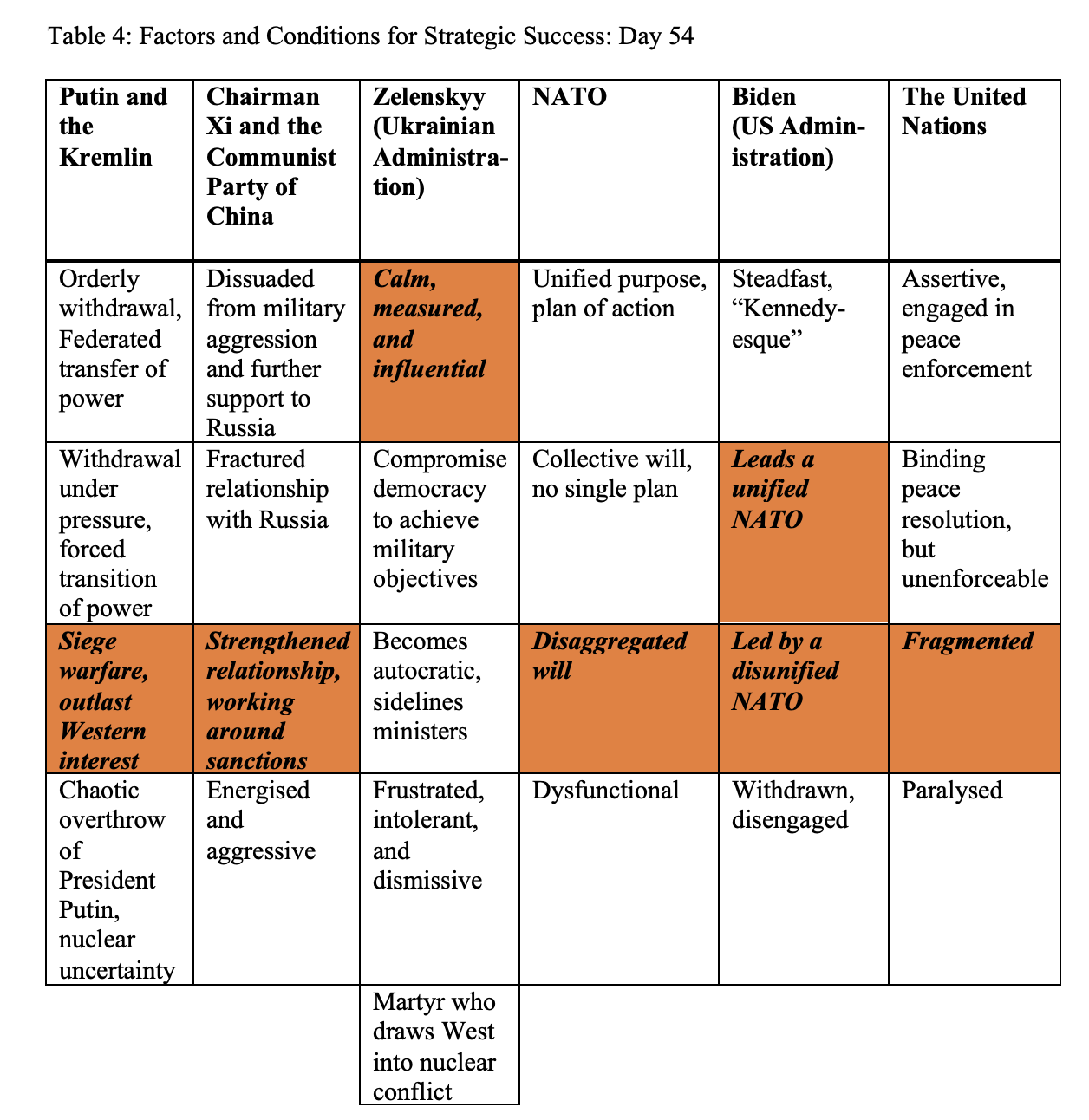
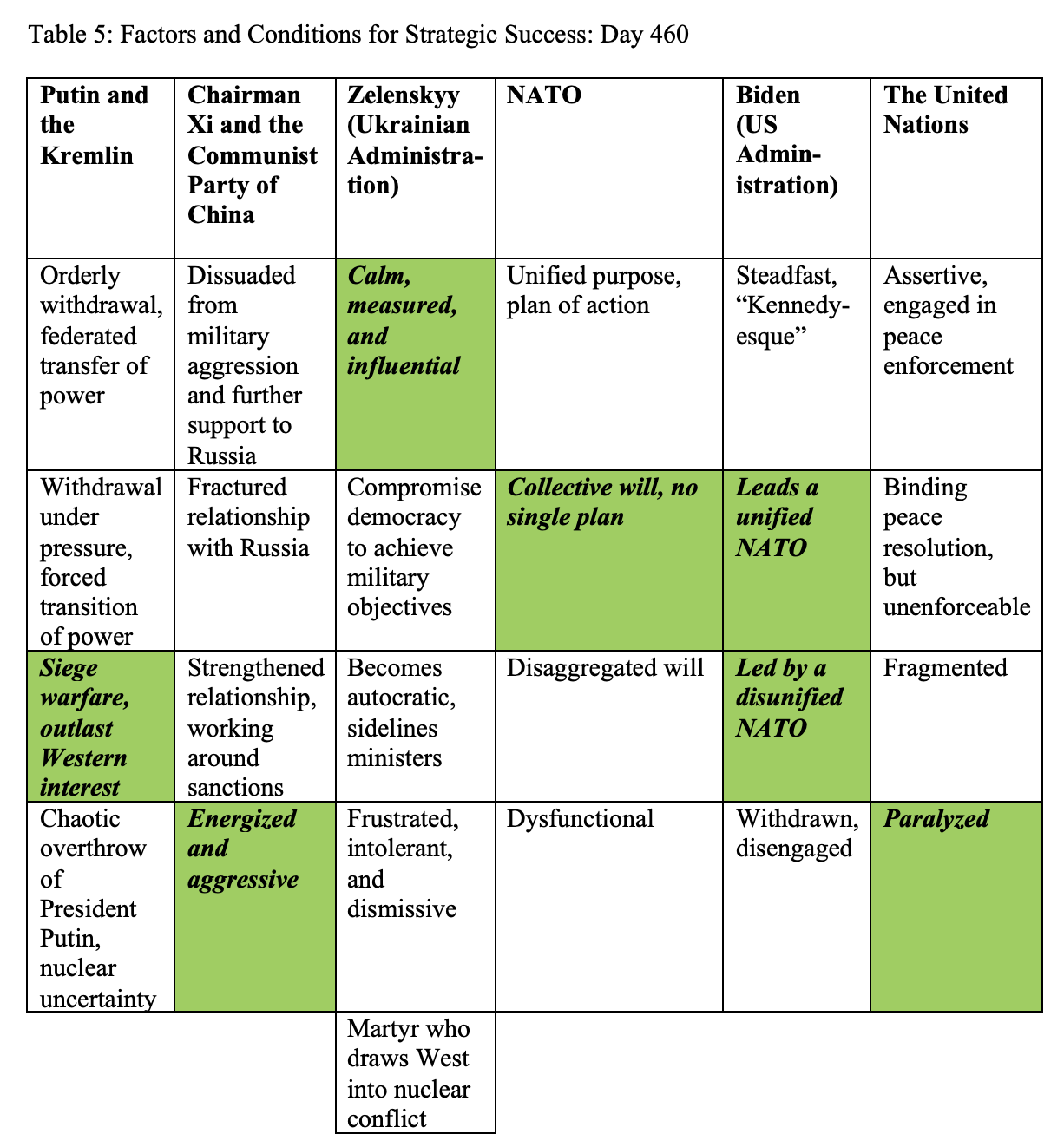
Note that in both tables, the two vertically adjacent boxes in the Biden-US column, “Leads a unified NATO” and “Led by a disunified NATO,” are highlighted. This is because conditions may be on the boundary or oscillate between the two.
Putin and the Kremlin: No Change
Putin appears indifferent to massive casualty levels, framing this as an essential sacrifice in the context of an existential threat—a narrative that Western enthusiasm for the total defeat of Russian forces deployed in Ukraine has encouraged. It is likely that Putin believes a strategy of incremental mobilization and protraction will sustain an attritional conflict until Western unity fractures and Western military support is less forthcoming.
Chairman Xi and the Communist Party of China: Condition has Deteriorated
China is maintaining a position of strategic ambiguity in the public arena, and while recent language from Beijing has been more critical of Russia, China is certainly cooperating with Russia in order to seize opportunities for economic advantage, such as facilitating international commerce in denominations other than the US dollar. It is also fascinating that China’s recent declaration of a 12-point “political settlement” plan to end the war threatens the legitimacy of its own actions in Taiwan. From Russia’s perspective, the special military operation represents a partial reunification of the Soviet empire. China’s ambitions equally represent an attempt at a reunification of claimed historical Chinese boundaries.
The war has drawn Russia closer to China, to the former’s detriment as President Xi Jinping asserts a dominant role in the relationship. Putin has felt the frustration of failing to secure what he considered straightforward military objectives, while China has adopted a peace-brokering role, with Xi posturing as a concerned international statesman and the 12-point plan presented as a reasonable and appropriate path out for both sides. China claims neutrality, yet repeatedly blocks UN efforts to condemn the invasion. China’s interest is to weaken and discredit the West, most notably the United States’ power and ability to maintain the global rules-based order. In addition, the Ukraine war might become a test case for the PLA’s ability and capability to invade Taiwan before Xi’s current end-of-term date of 2027. The Ukraine war has shown that an inferior military state can withstand and push back against aggression due to a fighting spirit, external support, and the shortcomings of the invading force. On the one hand, all these factors will make China very cautious regarding its offensive plans for Taiwan, but on the other hand, they might speed up its operational plans and designs for bringing a confrontation forward: attack while the United States and other Western nations are focused on and becoming diplomatically exhausted in Ukraine. For these reasons, a longer, semi-frozen conflict is in the interest of China’s leaders. What is more, it keeps US strategic focus, military resources, and planning bound to Europe rather than the Indo-Pacific region, where China’s strategic focus lies. Although China’s position could be characterised as energized and aggressive, it is still within a grey zone threshold. If Russia were to occupy all of Ukraine, China would become very bold with respect to Taiwan.
Zelenskyy and Ukrainian administration: No Change
Zelenskyy has continued to effectively promote the Ukrainian case on the international stage, while concurrently maintaining domestic political control. His overseas influence and ability to secure resources is without rival. His administration has shown ruthless determination to silence all critics and any accompanying calls for a negotiated settlement that does not restore full sovereignty, a stance that is somewhat helped by his status as a president elected on a platform of compromise but forced to fight. His public presence is always that of a leader who is deeply engaged in the struggle. He exudes confidence and a natural ability to communicate effortlessly on any international stage.
NATO: Condition Reset in Ukraine’s Favor
Beyond avoiding a major Russian victory, NATO’s member states have divergent interests in the Ukraine war. The eastern states seek Russia’s total defeat, while France and Germany, though at odds with each other, appear to take a more realistic view and, like the United States, have been cautious about how and how much to support Ukraine. The essential US national interest remains one of ensuring Russia’s maximalist ambitions are confounded. A dominant consideration is avoiding a situation where Ukraine joins NATO before it has made the necessary political, legal, and commercial reforms and has achieved a stable peace with Russia. While a unified front of support for Ukraine is politically necessary, problems such as paying for the rebuilding of Ukraine or avoiding involvement in a future insurgency in Ukraine’s eastern border regions are likely to be considerations.
Putin’s rhetoric surrounding Ukraine and the need for Russia to stave off NATO from its borders has been made hollow. Finland’s successful and Sweden’s pending applications to join NATO, both of which were done in direct response to the invasion of Ukraine, have significantly increased the number of NATO countries on Russia’s border. While the accession of Finland and Sweden into NATO will not change the military calculus, politically, it both undermines Putin’s narrative justifying the operation in Ukraine and strengthens the narrative that NATO seeks to contain Russia. Russia’s announcement that it is placing tactical nuclear weapons in Belarus is part of Putin’s response to the buildup of NATO on Russia’s periphery, as well as a mechanism to address security concerns the Belarusian government may have over blow-back from Ukraine or NATO countries for the Lukashenko government’s political, diplomatic, and military support for Russia’s invasion of Ukraine.
Biden and US Administration: No Change
The US administration has been roundly criticized for making only incremental increases in support for Ukraine, rather than giving Kyiv everything it needs to win the war. There is a fragile balance between providing the means to win the war decisively and providing the means to continue waging the war. Interestingly, sanctions against key Russian persons and entities have been forthcoming, yet some vital warfighting resources have been delayed, including from those nations that require US authorization to make such transfers.
To complicate matters, much of the US administration’s current focus is on the US Indo-Pacific strategy to contain China’s posturing toward Taiwan, with repeated and frequent interruptions for the conflict in Ukraine.
The United Nations: Condition has Deteriorated
Probably the most worrying aspect of this changed condition results from the United Nations’ inability or unwillingness to became actively engaged and, if not achieve a Russian withdrawal, then at least broker a period of negotiation. Russia’s unwillingness to negotiate is suggestive of an adversary fixated on one outcome and with an enthusiasm for further kinetic attacks on civilian infrastructure. The United Nations must act and shift its condition to one of “Assertive, engaged in peace enforcement” through the application of appropriate instruments. It is unlikely, however, that a Security Council resolution could be achieved, with Russia and China obviously at the center of considerations by virtue of their permanent seats there.
The UN’s inability to navigate the complexities of the Russia-Ukraine conflict is amplified by its immediate entry into the Sudan civil war dialogue and its announcements of a catastrophe and impending humanitarian crisis. Difficulties will persist in these partially governed or contested regions. If solutions cannot make progress in governed regions experiencing conflict, then there is little to be gained by the distraction of actively seeking decisions elsewhere. The Sudan action suggests a desire within the UN to shift attention from one crisis to another and thereby dilute the expectation for prompt and successful intervention.
Conclusion
Ukraine’s future, as it was captured as factors and conditions within the first set of Zwicky Boxes (April 2022), has arrived. A corresponding sanctioned and militarily weakened Russian future has also arrived. Movements within several European nations for NATO membership are Russia’s unintended consequences, while China has possibly come to some interesting realizations about what a smaller nation, especially one with big friends, can achieve when threatened.
The operational and strategic conditions have shifted as a result of events—things that were done and, more importantly, things that were not done. An escalation has been avoided. Nevertheless, pursuing the total defeat of Russia’s special military operation still runs an unknown risk of nuclear war and a significant risk of instability in Russia and bordering countries (Finland, Latvia, and Estonia, and also the Russian-aligned states of Kazakhstan, Georgia, and Azerbaijan). These changed conditions can be represented with some precision through the use of Zwicky Boxes. They can also be understood, explained, and used to invite more purposeful actions, through an accompanying dialogue on what actions might bring about movement from one condition to another.
________________________
About the Authors
Dr. Guy Duczynski is an adjunct senior lecturer at Edith Cowan University. He had over 40 years of service in Special Operations, including two operational tours in the counter-terrorism unit of the Australian Special Air Service and a deployment to Afghanistan, before retiring from military service in 2018. He also served in numerous appointments associated with operations, plans, training, capability development and operational analysis branches. His current research is in influence activities, operational design, campaign planning, faction liaison, information operations, capability development, and special operations, and he lectures regularly to strategic and operational-level planners.
Dr. Sascha-Dominik Dov Bachmann is a professor of law at the University of Canberra and the co-convenor of its newly established National Security Hub. He is a fellow at NATO SHAPE Brussels, a fellow at the Security Institute for Governance and Leadership in Africa, Faculty of Military Science, Stellenbosch University, and has been a regular visiting lecturer for the Australian Defence Force. He acted as NATO SME (Cyber and Rule of Law) for the 2011 Countering Hybrid Threats Experiment in Tallinn, Estonia and The Hague. Dr. Bachmann is the author of over 80 publications and a regular contributor to NATO's Legal Advisors Workshop Functional Area System (LAWFAS).
Lieutenant Colonel Matthew Smith assumed his current position as Divisional G5 in the Australian Army in 2021. Prior to this appointment he led strategies and concepts at Information Warfare Division and was the Commanding Officer of Task Group Taji in November 2018. Prior to deployment, he was the Commanding Officer of 1st Regiment, Royal Australian Artillery (2017-2018). He has also served in a variety of regimental roles within 4th Regiment, Royal Australian Artillery; instructional roles at the Royal Military College; and staff officer appointments in Headquarters 7th Combat Brigade, United Kingdom Defence Intelligence, and Defence Intelligence Organisation. LTC Smith has served in Cambodia, East Timor, Afghanistan and most recently in Iraq. He holds a Masters of Military Studies from the Australian National University, and a Master of Justice of Strategic Intelligence from Queensland University of Technology.
Dr Charles Knight researches risks, costs and capabilities for combat amongst structures and populations, with particular attention to how the urban fight is portrayed in mainstream and new media, and the competing narratives and informational factors involved. He is affiliated with Charles Sturt University, the University of New South Wales and the Thereisian Military Academy. His urban conflict research, PhD examining coercion during counterinsurgency and Masters study of asymmetric vulnerabilities in cities are informed by fieldwork in the Lebanon and Cambodia as well as by uniformed service with several militaries.
Copyright 2023, Guy Duczynski, Sascha-Dominik Dov Bachmann, Matthew Smith, Charles Knight. The US federal government is granted for itself and others acting on its behalf in perpetuity a paid-up, nonexclusive, irrevocable worldwide license in this work to reproduce, prepare derivative works, distribute copies to the public, and perform publicly and display publicly, by or on behalf of the US federal government. All other rights are reserved by the copyright owner(s). Foreign copyrights may apply.
Image Credits:
1. Ministry of Defence, OGL v1.0OGL v1.0, via Wikimedia Commons
[1]. See Guy Duczynski, Sascha Dov Bachmann, and Matthew Smith, “Operational Design: Imagination Needed in Ukraine,” ECCO Insights, 15 September 2:https://nps.edu/web/ecco/operational-design
[2]. Jonathan Masters, “Ukraine: Conflict at the Crossroads of Europe and Russia,” Council on Foreign Relations, 14 February 2023:Jonathan Masters, “Ukraine: Conflict at the Crossroads of Europe and Russia,” Council on Foreign Relations, 14 February 2023
[3]. Robert Hunter, “The Ukraine Crisis: Why and What Now?,” Survival: Global Politics and Strategy 64, no. 1 (2022): 7–28.
[4]. John J. Mearsheimer, “The Causes and Consequences of the Ukraine War,” Horizons: Journal of International Relations and Sustainable Development, no. 21 (2022): 12–27.
[5]. Fritz Zwicky, “The Morphological Approach to Discovery, Invention, Research and Construction,” in New Methods of Thought and Procedure, ed. F. Zwicky and A. G. Wilson (New York: Springer-Verlag, 1967), 273-297: https://link.springer.com/chapter/10.1007/978-3-642-87617-2_14 ; Duczynski, Bachmann, and Smith, “Operational Design.”
[6]. See Fritz Zwicky, “The Morphological Approach to Discovery, Invention, Research and Construction,” in New Methods of Thought and Procedure, ed. Fritz Zwicky and Albert G. Wilson (Berlin: Springer, 1967): 273–97: https://doi.org/10.1007/978-3-642-87617-2_14. Russell Rhyne suggests the following as a way to help determine which factors are most important in such an analysis: “A shaggy looking character comes off the hill and collars you and says, ‘My name is Rip van Winkle and I seem to have been asleep for the last 20 years. What are things like now? But keep it short; just tell me about the six parts that seem the most important.’” Russell Foote Rhyne, The Act of Choosing: A Context-Matching Theory, and Its Practical Implications (New York: iUniverse, Inc., 2003), 200.
[7]. See, for example, Seth G. Jones, Riley McCabe, and Alexander Palmer, “Ukrainian Innovation in a War of Attrition,” Center for Strategic and International Studies, 27 February 2023: https://www.csis.org/analysis/ukrainian-innovation-war-attrition
[8]. For a detailed explanation of how to create and use a Zwicky Box, see Duczynski, Bachmann, and Smith, “Operational Design,” 11–13.
[9]. It is helpful to assign a meaningful acronym to the factors, as doing so aids effortless recall of whole-field conditions and a deeper sense of the conditions within each. We were able to generate the word COMPELS with little effort.
[10]. The identification of a “tipping point” in the Russia-Ukraine conflict is critical to provide a focal point against which the West can maintain pressure. We regard a tipping point as a set of conditions under which victory (for Ukraine, in this case) is not yet secured, but that in combination represent a very uncomfortable and potentially disastrous situation for the other side. The tipping point we propose on Day 460 is the same as the one we proposed for Day 54, except that we now see “selective targeting” for Russia as a sufficient sign of increasing weakness to indicate a possible tipping point.
[11]. For more information, see “What’s Really Going On in Russia?” interview with Stephan Kotkin, The Ezra Klein Show (podcast), 30 June 2023: https://www.nytimes.com/2023/06/30/opinion/ezra-klein-podcast-stephen-kotkin.html
[12].Geoff Coyle, “The Nature and Value of Futures Studies or Do Futures Have a Future?” Futures 29, no. 1 (1997): 77–93:
[13].Peter Beaumont and Pjotr Sauer, “Russia Replaces General in Charge of Ukraine War in Latest Military Shake-up,” The Guardian, 11 January 2023: https://www.theguardian.com/world/2023/jan/11/russia-replaces-general-in-charge-of-ukraine-war-in-latest-military-shake-up
[14]. Media reporting suggests that many more generals have been killed than Russia has admitted to. See, for example, Brendan Cole, “Russian Generals Killed in War ‘Unbelievably High’: Japanese Intelligence,” Newsweek, 9 February 2023: https://www.newsweek.com/russian-generals-killed-war-ukraine-japanese-intelligence-1780131
[15]. Mariya Knight, Sugam Pokharel, and Brad Lendon, “Two Russian Commanders Killed in Ukraine Fighting, Defense Ministry Says,” CNN, 14 May 2023: https://edition.cnn.com/2023/05/14/asia/russian-colonels-killed-ukraine-intl-hnk/index.html#:~:text=The%20ministry%20said%20the%20two,troops%20in%20the%20Donetsk%20region
[16]. Prior to its 24 June 2023 mutiny, the Wagner Group had been Russia’s most “successful” mercenary outlet. It has had a significant impact on Russian interests around the world, most notably in Africa and Syria. See Karen Philippa Larsen and Flemming Splidsboel Hansen, Russia’s Comprehensive Approach and the Increased Use of the Wagner Group Challenges the West in Africa (Copenhagen: Danish Institute for International Studies, 2022).
[17]. Russia’s armed forces have NCOs, but they do not exercise tactical command and defer to senior officers for everything associated with the use of fire and maneuver in the smallest tactical element. As a result, Russian forces can be acutely unresponsive to changing situations. See, for example, Isabel Coles and Ievgeniia Sivorka, “How a Ukrainian Soldier’s Final Act of Defiance Made Him a Hero,” Wall Street Journal, 31 March 2023: https://www.wsj.com/articles/how-a-ukrainian-soldiers-final-act-of-defiance-made-him-a-hero-e22f5288
[18]. See, for example, Isabel Coles and Ievgeniia Sivorka, “How a Ukrainian Soldier’s Final Act of Defiance Made Him a Hero,” Wall Street Journal, 31 March 2023: https://www.wsj.com/articles/how-a-ukrainian-soldiers-final-act-of-defiance-made-him-a-hero-e22f5288
[19]. Ukraine’s prompt adoption of civilian drones demonstrates an extraordinary level of ingenuity in tactical surveillance. Cédric Pietralunga, “Russia and Ukraine Take Drone Warfare to Unprecedented Scale,” Le Monde, 18 June 2023: https://www.lemonde.fr/en/international/article/2023/06/18/russia-and-ukraine-take-drone-warfare-to-unprecedented-scale_6033281_4.html
[20]. The adoption of drones was followed almost immediately by the practice of attaching hand grenades fitted with 3D-printed fins to the drones in order to engage targets sheltering from small arms fire. Jones, McCabe, and Palmer, “Ukrainian Innovation in a War of Attrition.”
[21]. Robert Dalsjö, Michael Jonsson, and Johan Norberg, “A Brutal Examination: Russian Military Capability in Light of the Ukraine War,” Survival: Global Politics and Strategy 64, no. 3 (2022): 7–28.
[22]. Dan Ciuriak, “The Role of Social Media in Russia’s War on Ukraine,” SSRN, 5 May 2022: https://papers.ssrn.com/sol3/papers.cfm?abstract_id=4078863
[23]. Sam Kiley, “Ukraine’s Cross-Border Tactics are Aimed at Destabilizing Russia. Judging by the Response, They’re Working,” CNN, 3 June 2023: https://edition.cnn.com/2023/06/02/europe/ukraine-cross-border-tactics-analysis-intl/index.html
[24]. “Full Text: China’s Position on Political Settlement of Ukraine Crisis,” CGTN, 24 February 2023: https://news.cgtn.com/news/2023-02-24/Full-text-China-s-Position-on-Political-Settlement-of-Ukraine-Crisis-1hG2dcPYSNW/index.html
[25]. Dana Born, “Setting New Standards of Leadership” in “Lessons from a Year of War in Ukraine,” Harvard Kennedy School, 21 February 2023: https://www.hks.harvard.edu/faculty-research/policy-topics/international-relations-security/lessons-year-war-ukraine
[26]. Guy Faulconbridge, “Russia Moves Ahead with Deployment of Tactical Nukes in Belarus,” Reuters, 25 May 2023: https://www.reuters.com/business/aerospace-d
[27]. Patriot air defense batteries arrived in Ukraine in April 2023, while the delivery of Abrams armored vehicles was announced for September 2023. Obviously there are considerations concerning Ukraine’s capacity to absorb the volume of materiel; equally, there are considerations about the extent to which Russian military planners evaluate the changed force ratios.

